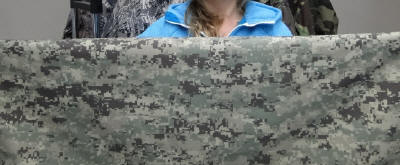Special Operations Forces (SOF) have, of necessity, always had to be at or near the cutting edge of a wide variety of technologies, both those that are avowedly military in nature and those adapted from other uses. And while nobody is likely to emerge completely unscathed from budget cuts, in the West at least, special operators are likely to do better than most.
 |
| French Special Forces, 1er RPIMa, aboard a VPS at the end of a patrol. (Photo: CCH J.Bardenet/SIRPA Terre) |
SOF will require ready-for-use systems and equipment to perform in the most complex mission scenarios. The
Commander of the German SEK-M Specialised Task Forces of the Navy, Capt. (S.G.) Stephan Plath said that the mission success of the battalion-sized unit, a potent force of combat swimmers, mine clearance divers, and boarding teams, is highly dependent upon the latest equipment and technologies the industry is offering. “
We constantly improve our capabilities by acquiring innovative products that are available on the market. This requires a careful analysis of what is available and which of our partners have similar requirements,” he said.
More recent Naval Special Forces operations underscored one tendency: the need for heavy-duty inflatable boats (RIB/RHIB) and high-speed interceptor craft (HSIC) to better cope with fast-running threats.
 |
| Special Forces are using a wide range of equipment and kit for breaching, rescue, recon and close protection. Shown is the Aimpoint CompM2 with the LRP mount. (Photo: Aimpoint) |
More Energy
Unsurprisingly, better batteries and other energy storage devices come at the top of every SOF the list. The US Special Operations Command (USSOCOM), for example, is seeking weight reductions of between 1:5 and 1:10 for standard issue batteries with equivalent energy capacities, plus micro-batteries that offer longer operating life for small devices in harsh environments. The organisation also called for an order of magnitude reduction in recharge time and batteries that are more robust to longer periods of use when subjected to temperature extremes. Still on the subject of power, the need is for stealthy and cost effective power generation along with low-maintenance power management and energy storage systems for use in austere locations by small units.
 |
| The Netherlands Special Forces include highly trained combat swimmer units, who are trained parachutist, scuba divers, and and demolition experts. (Photo: Mönch /AF) |
There is a vast amount of R&D into battery technologies around the world and the US DoD is heavily involved through various projects that DARPA is undertaking and though activities conducted by the forces laboratories, frequently in cooperation with industry. Meanwhile, the Defense Logistics Agency (DLA) is keen to make the most of advanced technologies developed for one application to others. For example, in mid-January the DLA awarded
Saft a $1.2 million contract to improve the Advanced Lithium Power Source (ALPS) battery used in the Long Range Advanced Scout Surveillance System (LRAS3), a vehicle-mounted SOF favourite.
 |
| The ALPS battery was developed as a compact energy storage unit with an integrated charger as a portable energy source in the field. In the new one, Saft will adapt components of the Lithium Battery Box (LBB) used in the Improved Target Acquisition System (ITAS) for the TOW missile. The result, says the company, will be a 100Ah battery operating at 24-28V and a built in charger that is fully compatible with 28V military vehicle batteries and AC generators. (Photo: Saft) |
“
The ALPS battery will provide greater power capacity, speed and efficiencies in the field which are crucial to mission success for our military personnel,” said
Thomas Alcide, General Manager of Saft’s Specialty Battery Group. “
Saft is proud that this contract and our partnership with the Defense Logistics Agency will result in manufacturing improvements that will meet additional tactical needs in the future.”
From early secondary batteries in the 1980s to today's lithium-ion systems,
Bren-tronics succeeded in engineering solutions that deliver the staying power of primary cell batteries with the extreme reusability demanded by today's Armed Forces. Bren-tronics continues to innovate with lithium polymer chemistries and solutions tailored for use with solar cells and fuel cells. One of the main benefits of rechargeable batteries is lower cost compared with batteries that must be replaced frequently. Bren-tronics knows that cost is key to the success of their products; yet, the company also knows that customers cannot afford that lower cost if it comes at the expense of reduced reliability. Rather than designing systems from the ground up to military specifications, the company keeps costs low by combining proven off-the-shelf technologies with their innovative solutions, and then ruggedising systems to meet mission requirements.
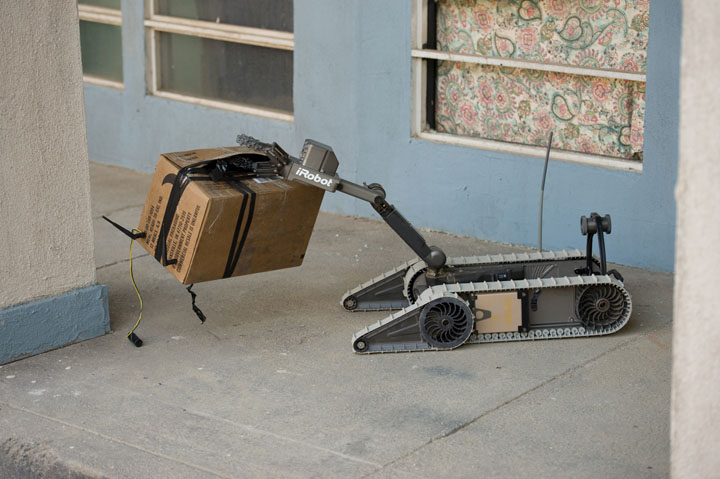 |
The Bren-Tronics BB-2590/U battery providing power for extreme needs, here for the iRobot PACKBOT.
(Photo: Bren-Tronics) |
Bren-tronics‘ Soldier Portable Charger (BTC-70801) and Soldier Portable Charger Lite (BTC-70819) are universal state-of-the-art, high performance lightweight portable battery chargers designed for field deployment or depot/shop usage. These universal chargers are currently capable of charging over hundreds of different types of military and commercial batteries with new ones being added regularly. The Soldier Portable Chargers are simple to use by design, they are capable of simultaneously charging two batteries completely unattended (up to eight batteries on the SPC). The charger automatically identifies the specific battery type and provides the appropriate charge profile. Based on the current operating environment, the SPC Lite automatically customizes the charge profile to provide the quickest charge in a safe manner. They can readily use either AC or DC input power - whichever is most convenient for the user.
 |
| The BTC-70801 is a state of the art portable battery charger designed for field or depot use. The charger is capable of charging up to 8 batteries (2 simultaneously, with 6 batteries in queue) with easy to follow LED lighting sequence. (Photo: Bren-tronics) |
In December, Bren-Tronics has released a new handheld radio battery. Available in a standard capacity 63W (BT-70716BE) or a high capacity version with 73W (BT-70716BG). The BT-70716B version battery is used within many systems including the AN/PRC-148, TRC-9110, and the Wave Relay MPU4, or can be incorporated in your future design. The batteries are fully supported from small charging systems, such as solar and desktop chargers to larger universal chargers that are currently available within the military system.
 |
| Bren-Tronics is an advanced designer and manufacturer of primary and rechargeable batteries, chargers, and complete storage systems from watt hours to megawatt hours. (Photo: Bren-tronics) |
SFC Energy provides dependable, quiet, and lightweight fuel cell solutions for defence applications. The company is well positioned as a solutions provider for mobile and man-portable power as a result of successful commercialisation of DMFC (Direct Methanol Fuel Cells) for several years. Products by SFC give soldiers in the field improved mobility, agility, effectiveness, and safety. USAF Special Operations Command (AFSOC), for example, fielded SFC Power Managers as part of the Battle Air Operations Kit (BAO) Kit to reduce weight and increase functionality in tactical power generation management needs.
The dismounted soldier‘s need for lightweight, reliable and portable electrical power supply is met by SFC’s excellent solutions. By combining the intelligent power solutions JENNY and the SFC Power Manager, a very efficient energy network is created. In combination, JENNY plus SFC Power Manager can recharge several batteries and power various equipment at the same time. The SFC solution establishes an energy network that delivers a maximum of power and flexibility at a minimum of weight. On a 72 hour mission for example, the weight burden of a soldier can be reduced by 80% in comparison to only having batteries to supply power.
 |
| On the occasion of the annual Special Operations Forces Industry Conference (SOFIC, May 2013) SFC Energy, a technology and market leader for portable, mobile, and off-grid power generation and distribution, has launched the new EMILY 3000 fuel cell generator for vehicle based defense applications. (Photo: SFC Energy) |
During operations, vehicles are required to supply power to on-board devices, such as radios, communication equipment, weapon systems, and EO systems. Moreover they act as a charging station for the soldier. Integrated into tactical vehicles or in the field, the SFC’s EMILY provides quiet, continuous and independent power supply. The fuel cell operates as a ruggedized fuel cell power generator for mobile devices ranging from radio and other communication equipment, night-vision and navigation devices, and computers – regardless of weather and climate.
This is how it works: When connected to a rechargeable battery, the SFC fuel cell will constantly monitor the battery’s charge state. Once this drops below a predefined value, the fuel cell will automatically start recharging the battery. Once the battery is completely recharged, the fuel cell automatically reverts to standby mode. The process involves no moving parts and no combustion whatsoever, emitting only carbon dioxide and water – no more than a child’s breath. SFC fuel cells use methanol as a fuel, a liquid alcohol, which comes in cartridges that are easy to store, transport and ship. Methanol is safe to use and poses no hazard to the soldier. Methanol’s most important property is its extremely high energy density at very low weight.
 |
| Function of Fuel Cells (Graphic: SFC Energy) |
 |
| Principle of SFC Energy Fuel Cells (Graphic: SFC Energy) |
SFC Energy – Military Charging Systems
SFC Energy is a market leader in fuel cell technologies for mobile and off-grid power applications. SFC has shipped more than 25,000 fully commercial products to law enforcement, defence, industrial, and private end users, and has created a convenient fuel cartridge supply infrastructure.
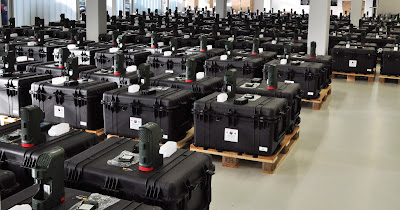 |
| (Photo: SFC Energy) |
The company has developed a strong customer base within the NATO and US defence communities. Fully integrated fuel cell/battery hybrid systems by SFC Energy offer militaries around the world a wide range of safe, lightweight and independent power sources for nonstop equipment operation by soldiers in the field. Solutions range from vehicle based power generators to turnkey energy solutions used as field charging devices and finally to lightweight man portable systems as an alternative to carrying spare batteries.
100 Scenarios - 1 Power Solution – Enabled by Portable Power Management
The modern soldier faces a wide variety of different mission scenarios and objectives. As the performance and therefore the power demand of modern communication- and reconnaissance equipment are increasing, intelligent systems for reliable off-grid power supply during a mission gain importance.
SFC Energy has developed a highly efficient energy network to meet these demands. SFC’s energy network consists of the portable JENNY fuel cell generator, the SFC Power Manager, a hybrid battery, foldable solar panel for additional power supply, and smart accessories. This energy network can easily be adapted to the needs of different forces and nations, depending on the mission scenarios.
This high efficient and especially flexible power supply enables powering different equipment – e.g. radios, GPS, night vision goggles, laser distance meters, laptops and PDAs – for stationary as well as portable use.
Using the SFC energy network, power supply and energy management take place fully automatically, silently, emission-free and with no risk of being detected (aural/IR). Additionally in comparison to conventional batteries this SFC energy solution reduces the weight a soldier has to carry on a 72 hour mission by 80 per cent.
 |
| JENNY and SFC Power Manager – a strong hybrid system to power portable equipment and recharge batteries. (Photo: SFC Energy) |
Enhanced Safety and Runtime for Silent Watch Missions, Command and Operation Posts
SFC’s EMILY fuel cell generator has proven itself for reliably powering electric equipment on board of vehicles. EMILY fuel cell generator reliably charges the radio battery or on-board battery of military command and multipurpose vehicles fully automatically, ensuring permanent availability of equipment. This way, electrical equipment can be used and powered during silent watch missions without having to start the engine, not producing any detectable sound or heat signature.
SFC’s EMILYCube reliably powers equipment in the field during reconnaissance missions, as for example portable radar systems and communication devices. At the same time, EMILYCube energy solution can be used as charging station for portable devices. The system contains an integrated fuel cartridge and hybrid battery and therefore is ready to use at any time. With this compact energy solution, 11kWh of energy are available while weighing only 21kg (48,5lbs). This is sufficient to reliably power the equipment mentioned above for many days without user intervention.
 |
| USASOC Special Operations Forces in Afghanistan (Photo: USASOC) |
More power and efficiency for small boats is also on the agenda, with SOCOM seeking advanced power systems for combat surface craft, systems that provide significantly better power-to-weight ratios at top speed and greater fuel efficiency in cruise. In terms of numbers, the goals are 1hp/lb and, in specific fuel consumption terms, 0.1lb/hp per hour. These ‘power systems’ must also be significantly lighter, more reliable and easier to maintain than the engines SOCOM currently uses while running on light to heavy fuels or military common use fuels such as JP5 and JP8.
In this context, Finnish heavy-duty Rigid Inflatable Boat (RIB) builder
Boomeranger announced in February that it has been chosen to supply the Royal Swedish Navy with a 9.2m special operations boat to be based on HMS CARLSKRONA for anti-piracy duties in the EU’s ATALANTA operation off the coast of Somalia this year. US marine engine manufacturer Evinrude makes a range of multi-fuel outboard engines for the military and security forces – and now offers some to the public – engines that can run on kerosene, JP4, JP5, JP8 and Jet B, as well as standard gasoline. The operator can change the engine settings to suit whatever fuel is available with the flick of a switch and without compromising performance, says the company. The engines can drive either a propeller or a pump jet.
Under the water, the desire is for energy storage systems that provide submersibles with great energy density while remaining safe and improving on service life and costs.
 |
| (Photo: US SOCOM) |
SOCOM is moving towards what it terms “dry combat submersibles” for SEAL delivery missions, among others, because they are not subject to the same human diving limitations that traditional “wet” diver delivery vehicles are. Dry submersibles offer normal life support for 24 hours and reserve life support for 72. In December, SOCOM awarded
General Dynamics’ Electric Boat an R&D contract for a user operational evaluation system. This contract, valued at $44.3 million, will involve the design, construction, test and delivery of a complete, commercially classed prototype dry combat submersible system.
The four Type F125 (BADEN-WÜRTTEMBERG class) frigates built by
ThyssenKrupp Marine Systems (
TKMS) and
Fr. Lürssen Werft for the German Navy, which will provide space for Special Forces, receive specially designed RIB to enable them to operate in the harshest environmental conditions. According to René Quezada of
Fr. Fassmer, two prototypes of a 10.5m RIB are now being tested in the North Sea.
 |
| German Special Forces teams from the Naval Air Wing 5 in Kiel and the Naval Engineering School in Parow equipped with 9m RHIBs. (Photo via Guy Toremans) |
Better C4, More Software Radios
The inclusion of low profile, concealable or conformal antennas that work over wide and/or narrow frequency bands and on single or multiple platforms is essential in the field. Beyond-Line-of-Sight (BloS) and denied area communications with more capacity and capability are also wanted, combined with Low-Probability-of-Interest (LPI) and Low-Probability-of-Detection (LPD) characteristics.
Software defined radios are a key enabling technology for all of these needs; and, e.g., SOCOM has been buying lots of them from, for example, Harris. On 7 January the company announced an order worth $7 million for additional FALCON III AN/PRC-117G multiband manpack radios and accessories.
 |
| Aselsan’s SDNR Family (Handheld, MANPACK, Vehicular and Base Station) is able to provide seamless communications among tactical users through secure voice, data and video. (Photo: Aselsan) |
SOCOM is in the process of replacing its legacy Multi-Band Inter/intra Team Radio (MBITR) radios and, in January,
Thales Communications introduced a radio that it hopes will take its place. The MBITR2, says the company, is the world’s first simultaneous two-channel handheld radio, which enables dismounted soldiers to: “
integrate into the wideband tactical IP and voice network via the Soldier Radio Waveform (SRW) wideband channel while simultaneously maintaining legacy reach-back via the narrowband channel.”
More than 200,000 AN/PRC-148 MBITRs are currently fielded, says Thales Communications, so the replacement market is potentially very lucrative. MBITR’s compatibility with the AN/PRC-154 RIFLEMAN Radio is significant because it improves SOF interoperability with supporting troops, such as the US Army Rangers. The RIFLEMAN radio is a joint development of
Thales Communications and
General Dynamics C4 Systems (
GDC4S). A lightweight, body-worn radio that is part of the Joint Tactical Radio System Handheld, Manpack and Small Form Factor (JTRS HMS) programme, it brings Type-2 security to squad level communications, transmitting voice and data simultaneously using the Soldier Radio Waveform (SRW). In this way, it provides soldiers at the tactical edge with mobile voice, video and data communications similar to those available through commercial cellular networks, says General Dynamics.
With over 30 years of experience and continuous development in communications field, Aselsan is known as one of the few Software Defined Networking Radio (SDNR) producers in the world, having met the demand of the Turkish Armed Forces, and having exported to many allied countries not only as direct sales but also as technology transfer and local production.
 |
| Romanian 1st Special Operations Battalion soldiers sporting the US Army SF SSI. (Photo: Romanian Special Forces) |
Aselsan’s SDNR Family (Handheld, MANPACK, Vehicular and Base Station) ensures increased survivability against Electronic Warfare (EW) threats by providing alternative communication means over a wideband ranging from 2-30 MHz HF to 30-512 MHz V/UHF. Software configurable architecture enables various tactical radio waveforms and advanced EPM techniques on the same platform.
The SDNR provides multi-band and multimode secure voice and data communications and supports advanced ECCM techniques. The radio can be customised according to different national needs by its built-in programmable encryption module which has the capability to support many different crypto algorithms required by different waveforms. The V/UHF SDNR is designed to provide public safety and air-to-ground-to-air communications capability as well as tactical communications under severe electronic warfare threats. Meanwhile, HF SDNR is designed to provide frequency hopping and encrypted long range strategic voice and data communication. The V/UHF SDNR provides all NATO defined tactical radio functionalities such as: Combat Net Radio (CNR), Broad Band Packet Radio (BBPR), Narrow Band Packet Radio (NBPR) and Single Channel Radio Access (SCRA) functionalities. Today the V/UHF SDNR radio is the only available radio that supports all the tactical communication functions defined by the NATO Tacoms Post 2000 and to provide wideband high speed data service. The V/UHF SDNR is also the only radio today that supports simultaneous voice and data using the Wide Band Networking Radio Waveform (WBNR) mode.
The SDNR features a Man-Machine Interface (MMI) very similar to cellular phones. This helps the users adapt rapidly to the controls of the radio. The alphanumeric keypad of the radio enables Short Message Service feature on different waveforms supported by the radio. The SDNR also has a GPS interface where various GPS receivers can be connected to this radio to download and utilize location data. In the WBNR mode the V/UHF SDNR can automatically distribute the GPS data in the radio network. The V/UHF SDNR has the hardware capability to perform 300 million instructions per seconds and supports six different waveforms implemented on 1.5 million lines of code. The V/UHF SDNR supports narrowband (FM, AM), frequency hopping encrypted waveforms as well as supporting wide band (high speed data) networking waveform with Direct Sequence Spread Spectrum technique.
One of the most advanced features of the V/UHF SDNR is the frequency hopping scan and waveform scan capabilities. In the frequency hopping waveforms (VHF/FM Low Band Waveform and Advanced CNR (A-CNR) Waveform) the V/UHF SDNR has the capability to scan between frequency hopping nets.
When speaking of SDRs, one must mention
Rohde & Schwarz’ (
R&S) recently unveiled R&S Software Defined Tactical Radio (SDTR), enabling high data rate, jam-resistant communications in network centric operations. The R&S SDTR is the first in a new generation of software defined radios (SDR), together with a family of network capable waveforms. This tactical radio for vehicular and semi-mobile platforms delivers 50W of output power without external amplifiers and covers the 30-512MHz range. It meets the military's special requirements on shock resistance, size, weight and ventilation without the need for extra mechanical shock absorbers. Thanks to integrated high-performance filters, antennas can be spaced as close as one meter apart and the radio lines will not interfere with each other. The R&S SDTR, with the R&S HDR waveforms, is fully IP capable and can be easily and seamlessly integrated into existing IP networks.
 |
| Rohde & Schwarz' R&S Software Defined Tactical Radio (SDTR). (Photo: R&S) |
See Through Walls
Camero’s 3-10 GHz, 660 g XAVER 100 is a device that can be operated with one hand. The company developed it specifically for tactical operators to provide them with “
instant critical situational awareness and target acquisition data.” Claimed to reliably detect stationary and moving people behind most common wall materials, it also offers a stand-off mode in which it can be positioned at a distance from the wall, although how far is not revealed. It is not an imaging device, but shows targets as dots on a screen against a range scale, a so-called 1D display. It can also be used from inside a building to act as a virtual window to spot approaching threats.
 |
| Camero’s tripod-mounted XAVER 800 is described as a full 3D ISR device that offers a wire frame perspective view of the space on the other side of the wall and enough target shape resolution, according to the literature, to make out a human form. Weighing 14.5kg including battery it has four distinctive square antenna lobes, one at each corner, and offers a range resolution finer than 3 cm. It can operate for two hours on rechargeable batteries and can be carried and operated by one person, says the company. (Photo: Camero) |
The larger 3.2 kg XAVER 400 is a two-handed device with a longer battery life of seven hours and finer range resolution of around 5cm compared with 15cm. It also features a larger 2D display that can also reveal general room layout and major structural elements.
TiaLinx offers a competing range of products known as EAGLE, COUGAR and PHOENIX.
L-3 Communications Cyterra makes a pair of one-hand devices known as EMMDAR (Electro-Magnetic Motion Detection And Ranging) and RANGE-R. Cyterra says that the AN/PPS-26 EMMDAR informs the user of the presence of and range to moving or near-stationary personnel. More forthcoming in its description of RANGE-R, Cyterra reveals that it uses L-3’s patented Stepped Frequency Continuous Wave (SFCW) radar technology and proprietary target detection algorithms that enable it to operate as a highly sensitive Doppler motion detector, claiming that it is the smallest and lightest through-wall sensor available.
Selex offers a two-handed device comparable with the XAVER 400 known as ERKOS.
PKI Electronic Intelligence makes the model 7405, which uses a hand held scanner linked to a briefcase control and display unit.
Acustek produces a one-handed device, the ACU-CPR4, with a simple, intuitive display and an ‘outstanding’ operational time of up to 16 hr on standard batteries.
AKELA has developed a tripod-mounted system with a significant standoff range. The AKELA Standoff Though-wall Imaging Radar (ASTIR) can be used from up to 30m from the wall to increase operator safety and features a wider viewing angle that enables detections within multi-level structures from a single position.
Cambridge Consultants’ PRISM 200 is a 5.7kg, two-handed device, although it can be operated with one arm when held against a wall, that can run for 4.5 hours or stand by for 24 hours on batteries and can accept external power. It will detect people through brick, block or concrete walls, show 3D perspective, plan and side elevation views and interface with a laptop or computer network. It can be mounted on a tripod for long term monitoring.
RETIA’s two-handed, 7.2kg ReTWis runs for up to nine hours on batteries and accepts 24V, 2.7A DC external power and, says the company, has been tested on brick, concrete, reinforced concrete, perforated brick, hollow brick, adobe, wood, stucco, cinder block and drywall. The display offers a full-featured 2D view enhanced by intelligent noise rejection and an advanced history panel to improve image quality in cluttered conditions. It also offers a 3D display and a ‘shadowed’ display mode designed to improve reliability by revealing potential radar dead zones.
Another way of seeing into an enclosed space from the outside is to throw a robot in, like
iRobot’s FIRSTLOOK, or
Recon Robotics’ RECON THROWBOT.
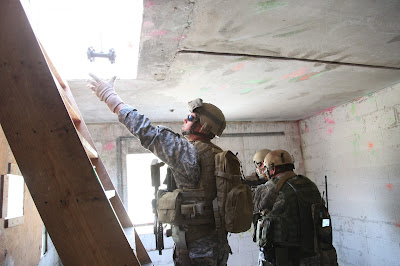 |
| Another way of seeing into enclosed spaces from the outside or vice versa is to throw a robot in, like here, Recon Robotics’ RECON THROWBOT. (Photo: Recon Robotics) |
Less Weight, More Firepower
Mirrored in continuing SOF operations worldwide is the need for improved weaponry, including better ammunition, but also mission-proven C2 and communications means, light ballistic protection, and miniaturised detection and situation awareness sensors. Especially in light of current threats in urban terrain, operations have demonstrated the need for shooter detection systems to provide SOF with some means to rapidly pinpoint the source of incoming hostile high-velocity fire. For these purposes, the PILARw MkII gunshot detection device from
01dB-Metravib displays the exact position of a gunshot in grid coordinates and in real-time allowing to pinpoint the threat. Its detection range is quoted at 1,500m. An innovative approach is
Microflown-Avisa’s dismounted soldier gunshot localisation device, the Acoustic Vector Sensor (AVS). The 150g device is in the form of a small metal tube measuring in size of a pen. A first variant of the system is already in use with the Dutch Army in Afghanistan as a counter-rocket, artillery and mortar warning sensor. A future version could be adapted to mini-drones, and a rifle-mounted version will be also offered.
 |
| Microflown-Avisa's RAM-LOC is designed to be used as part of a C-RAM (Counter Rocket, Artillery and Mortar) system, locating enemy firing positions over a wide area. (Graphic: Microflown-Avisa) |
Improved ballistic protection helps Naval Special Forces survive in combat missions.
DSM Dyneema was recently awarded a contract to supply the Norwegian Armed Forces with a new ballistic combat helmet called FAST (Future Assault Shell Technology). Another product in this category, ENDUMAX from
Teijin Aramid is described as the material of choice for modern protection equipment. ENDUMAX, which is also made from UHMWPE polymers, according to the company, is 11x stronger than steel at the same weight, while its stiffness is comparable to carbon fibres. When combined with light and flexible vests made from Teijin Aramid’s TWARON aramid materials, ENDUMAX lightweight insert plates enable ballistic protection gears to cope with the highest demands in terms of protection and low weight.
 |
| Special Operations Forces are military units highly-trained to perform unconventional, often high-risk missions. |
SOF will also benefit from innovations in the field of small-calibre weapons and ammunition. Among the multitude of manufacturers, there are several companies that attracted the interest of Special Forces operating in the maritime combat environment, including
Česká Zbrojovka, offering the CZ 805 BREN A1/A2 5.56x45mm NATO modular automatic rifles of which the A2 carbine is a more compact version of the modular A1 assault rifle in 5.56x45mm NATO calibre, from which it differs by a shorter barrel;
FN Herstal, marketing the FN SCAR family of assault rifles available in 5.56 and 7.62 NATO calibres that are easy to change between short (CQC) and standard rifles);
Israel Weapon Industries (
IWI), developing the MEGA GUN JERICHO Pistol Rifle Converter 9x19mm, turning the JERICHO pistol into a short semi-automatic rifle;
Heckler & Koch (
H&K), developing the DMR762-MR rifle, which is in use in Afghanistan since 2012;
Kriss Systems, offering the Kriss VECTOR family of recoilless weapons;
Primetake, offering door-breaching rounds, electric/non-electric detonators, less-than-lethal ammunition; and
RUAG Ammotec.
The latter developed the .338 LM/8.6x70 SWISS P Subsonic ammunition that can be individually adapted to different weapon types, including Accuracy International’s 338AWM. A unique feature of this ammunition is that filling of the cartridge and bullet configuration are individually matched to the weapon system concerned. The maximum operative range of the .338 LM/8.6x70 Swiss P Subsonic is 300 metres.
As the demand for lethal but also non-lethal weapons is increasing to fulfil the missions in the battle against terrorism, SOF bring in their ideas and experiences to the industry in order to get the right products to the right time. Jörg Hildebrandt of Germany’s
Metallwerk Elisenhütte (
MEN), for example, said that the element of surprise is crucial for some special missions requiring projectiles with a high stopping force and stable ballistic trajectory as well as high degree of penetrability and accuracy beyond ranges of 300 metres.
 |
| The Jagdkommando is the Austrian Armed Forces' Special Operations group. Jagdkommando soldiers are highly trained professionals whose thorough and rigorous training enables them to take over when tasks or situations outgrow the capabilities and specialisation of conventional units. (Photo: Mönch /AF) |
Non-Explosive Armour Piercing Incendiary (API) Completes the RUAG SWISS P Product Range for Anti-Material Missions
Towards the end of 2012, RUAG Ammotec developed and tested the new product of calibre .338 LM in Thun. The bullet features an insensitive metal tip which forms sparks on impacting hard targets, the bullet core penetrates the target. The ballistics are coordinated with those of the other RUAG SWISS P bullets (Armour Piercing, Ball and Target).
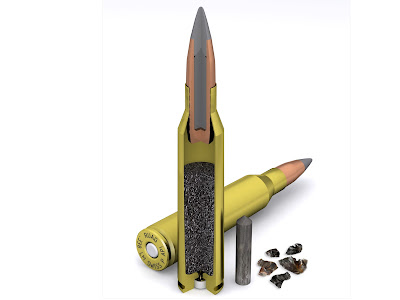 |
| RUAG Ammotec's new calibre .338 LM (Photo: RUAG) |
Reliability is what counts in military or police interventions under difficult conditions and in adverse weather. The new product of the snipers' ammunition RUAG SWISS P is also suitable for military purposes, since it is sealed, waterproof and temperature-stable.
The bullet of boat-tail design has a metal tip of titanium, a hard core of tungsten carbide and a brass jacket. The cartridge complies with the CIP standard and is filled in Switzerland. It contains a temperature-stable high-performance propellant, which makes it particularly suitable for military snipers and designated marksmen. The trio consisting of .338 LAPUA Mag. SWISS P Ball, .338 LAPUA Mag. SWISS P Armour Piercing and .338 LAPUA Mag. SWISS P Target is a good, well-tuned solution for a variety of operations. The .338 LAPUA Mag. SWISS P API is primarily used by snipers. It enhances the visibility of the impact so that the sniper or spotter can better detect the impact and make corrections earlier. Moreover, the new product can serve to mark the target and thus enable the own troops to see the enemy target thanks to the sparks. Firing is on hard targets for which AP are also used. It is planned that the API cartridge will also be available in the calibres 5.56x45, .308 Win., .300 Win. Mag. and .50 Browning in future.
At IDEX 2013, RUAG Ammotec furthermore launched a subsonic ammunition individually adapted to different weapon types, especially for snipers. Particular attention is paid to the barrel length and length of twist to achieve optimal ballistics and perfect precision. The enquiries and close cooperation with customers eventually prompted RUAG Ammotec to expand its RUAG SWISS P range by the new .338 LM / 8.6x70 SWISS P Subsonic. Unique about this new product is that filling of the cartridge and bullet configuration are individually matched to the weapon system concerned.
The extra benefit for the sniper is obvious: This subsonic ammunition of RUAG Ammotec suits the weapon outstandingly well because the bullet mass is exactly matched to the weapon's barrel type, length and twist. The perfect cartridge configuration for the particular weapon specification. The new ammunition thus guarantees an impeccable and exceptionally good weapon function. A further plus is that all cartridges meet the military requirements. They are sealed, waterproof and temperature-stable. The product ensures small velocity spans in both temperature band (cold-warm) and „inclined“ shooting (upwards/downwards). In the future RUAG Ammotec will increasingly develop individual solutions and products tailored to satisfy the customers' requirements.
 |
| The Belgian Special Forces Group is a Special Forces unit in the Land Component of the Belgian Armed Forces. (Photo: Mönch /AF) |
Extended Capabilities Require Specialised Equipment
SOF need specialised equipment to cope with missions under extremely severe conditions. The equipment varies from excellent new sensors, communications devices, decision aids, fuel cells, and stand-alone, plug-in-play charging stations to diver propulsion systems and tiny robotic vehicles designed to function in all likely environments. In the field of multifunctional thermal imaging technology, the integrated optoelectronics company
Jenoptik recently launched NYXUS BIRD, a new thermal imager combining day/night vision with a target localisation capability. The device, weighing less than 1.5kg, has a monocular daylight channel plus a cooled 3-5 microns IR channel. It is primarily designed for use by infantry and Special Forces, including combat swimmers.
First introduced in 2000, nearly 300,000
Airmpoint CompM2 sights are now in use by many elite Special Forces around the world. The CompM2, also known as the M68/CCO (when used by US forces), is the standard sight for the US Army and USAF, as well as the Armed Forces of many NATO countries. Due to its compatibility with all generations of night vision device (NVD), the CompM2 is ready for use around the clock. The CompM2 holds up under the roughest physical handling and can withstand the most severe weather conditions and temperatures. In fact, the CompM2 is completely submersible and will withstand pressures up to 2,5 atmospheres allowing it to be taken up to 25m underwater.
 |
| The German Fernspäher surveillance and reconnaissance soldier belongs to a highly specialised unit of the German Army. (Photo: Mönch /AF) |
For full article, please see MILITARY TECHNOLOGY magazine #2/2013. 



